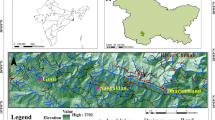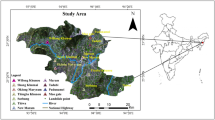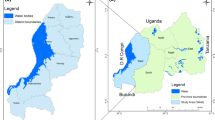Abstract
Landslide is recurrent phenomena in the Mandakini valley of Uttarakhand, India. This study concentrates on the analysis of landslide susceptibility mapping using Frequency Ratio (FR) and Analytical Hierarchical Process (AHP) models in the lower Mandakini valley. The models are applied by integrating eleven causative factors and 160 past landslides. Both models are validated and compared using Receiver Operating Characteristics and Seed Cell Area Index method. The validation result shows that the FR model gives better success rate and prediction rate than AHP model. Seed cell index values of high and very high susceptibility classes are more in the case of the FR model than AHP model. Thus, the landslide prediction capability of the FR model is more reliable in the study area. The study will contribute to understand future landslide risk and help in disaster reduction planning in the region.







Similar content being viewed by others
References
Achour, Y., Boumezbeur, A., Hadji, R., Chouabbi, A., Cavaleiro, V., & Bendaoud, E. A. (2017). Landslide susceptibility mapping using analytic hierarchy process and information value methods along with a highway road section in Constantine, Algeria. Arabian Journal of Geoscience,10(8), 194. https://doi.org/10.1007/s12517-017-2980-6.
Anbalagan, R. (1992). Landslide hazard evaluation and zonation mapping in mountainous terrain. Engineering Geology,32(4), 269–277.
Bui, D. T., Pradhan, B., Lofman, O., Revhaug, I., Dick, O. B. (2012). Landslide susceptibility assessment in the Hoa Binh province of Vietnam: A comparison of the Levenberg-Marquardt and Bayesian regularized neural networks. Geomorphology, 171, 12–29.
Casadei, M., Dietrich, W. E., & Miller, N. L. (2003). Testing a model for predicting the time and location of shallow landslide initiation in soil-mantled landscapes. Earth Surface Processes and Landforms,28(9), 925–950.
Champatiray, P. K., Dimri, S., Lakhera, R. C., & Sati, S. (2007). Fuzzy-based method for landslide hazard assessment in active seismic zone of Himalaya. Landslides,4(2), 101–111.
Chen, W., Chai, H., Sun, X., Wang, Q., Ding, X., Hong, H. (2016). A GIS-based comparative study of frequency ratio, statistical index and weights-of-evidence models in landslide susceptibility mapping. Arabian Journal of Geosciences. http://doi.org/10.1007/s12517-015-2150-7.
Chen, W., Pourghasemi, H. R., & Zhao, Z. (2017a). A GIS-based comparative study of Dempster-Shafer, logistic regression and artificial neural network models for landslide susceptibility mapping. Geocarto International,32(4), 367–385. https://doi.org/10.1080/10106049.2016.1140824.
Chen, W., Xie, X., Wang, J., Pradhan, B., Hong, H., Bui, D. T., et al. (2017b). A comparative study of logistic model tree, random forest, and classification and regression tree models for spatial prediction of landslide susceptibility. Catena,151, 147–160.
Choubey, V. M., Bist, K. K., Saini, N. N., & Ramola, R. R. (1999). Relation between soil-gas radon variation and different lithotectonic units, Garhwal Himalaya, India. Applied Radiation and Isotopes,51(5), 587–592.
Dahal, R. K., Hasegawa, S., Nonomura, A., Yamanaka, M., Masuda, T., & Nishino, K. (2007). GIS-based weights-of-evidence modeling of rainfall-induced landslides in small catchments for landslide susceptibility mapping. Environmental Geology,54(2), 311–324.
Dai, F. C., & Lee, C. F. (2002). Landslide characteristics and slope instability modeling using GIS, Lantau Island, Hong Kong. Geomorphology,42(3–4), 213–228.
Dehnavi, A., Aghdam, I. N., Pradhan, B., & Varzandeh, M. H. M. (2015). A new hybrid model using step-wise weight assessment ratio analysis (SWARA) technique and adaptive neuro-fuzzy inference system (ANFIS) for regional landslide hazard assessment in Iran. Catena,135, 122–148.
Demir, G., Aytekin, M., Akgun, A., Ikizler, S. B., & Tatar, O. (2013). A comparison of landslide susceptibility mapping of the eastern part of the North Anatolian Fault Zone (Turkey) by likelihood-frequency ratio and analytic hierarchy process methods. Natural Hazards,65(3), 1481–1506.
Disaster Mitigation and Management Centre. (2014). Geological investigations in Rudraprayag district with special reference to mass instability (pp. 24–51). Dehradun: Government of Uttarakhand.
Dou, J., Yanagishi, H., Pourghasemi, H. R., Yunus, A. P., Song, X., Xu, Y., et al. (2015). An integrated artificial neural network model for the landslide susceptibility assessment of Osado Island, Japan. Natural Hazards,78(3), 1749–1776. https://doi.org/10.1007/s11069-015-1799-2.
Egan, J. P. (1975). Signal detection theory and ROC analysis. New York: Academic Press.
Guzzetti, F., Mondini, A. C., Cardinali, M., Fiorucci, F., Santangelo, M., & Chang, K. T. (2012). Landslide inventory maps: New tools for old problem. Earth-Science Review,112(1–2), 42–66.
Huang, J., Zhou, Q., & Wang, F. (2015). Mapping the landslide susceptibility in Lantau Island, Hong Kong, by frequency ratio and logistic regression model. Annals of GIS,21(3), 191–208.
Jebur, M. N., Pradhan, B., Shafri, H. Z. M., Yusoff, Z. M., & Tehrany, M. S. (2015). An integrated user-friendly ArcMAP tool for bivariate statistical modelling in geoscience applications. Geoscientific Model Development,8(3), 881–891.
Kannan, M., Saranathan, E., & Anabalagan, R. (2012a). Landslide vulnerability mapping using frequency ratio model: A geospatial approach in Bodi-Bodimettu Ghat section, Theni district, Tamil Nadu, India. Arabian Journal of Geosciences,6(8), 2901–2913. https://doi.org/10.1007/s12517-012-0587-5.
Kannan, M., Saranathan, E., & Anbalagan, R. (2012b). Landslide vulnerability mapping using frequency ratio model: A geospatial approach in Bodi-Bodimettu Ghat section, Theni district, Tamil Nadu, India. Arabian Journal of Geoscience,6(8), 2901–2913.
Khattri, K. N., Chander, R., Gaur, V. K., Sarkar, I., & Kumar, S. (1989). New seismological results on the tectonics of the Garhwal Himalaya. Proceedings of the Indian Academy of Sciences: Earth and Planetary Science,98(1), 91–109.
Khosravi, K., Pham, B. T., Chapi, K., Shirzadi, A., Shahabi, H., & Revhaug, I. (2018). A comparative assessment of decision trees algorithms for flash flood susceptibility modeling at Haraz watershed, northern Iran. Science of the Total Environment,627, 744–755.
Kienholz, H., Schneider, G., Bichsel, M., Grunder, M., & Mool, P. (1984). Mapping of mountain hazards and slope stability. Mountain Research and Development,4(3), 247–266.
Kumar, R., & Anbalagan, R. (2014). Landslide susceptibility zonation in part of Tehri reservoir region using frequency ratio, fuzzy logic and GIS. Journal of Earth System Science,124(2), 431–448.
Kumar, R., & Anbalagan, R. (2016). Landslide susceptibility mapping using analytical hierarchy process (AHP) in Tehri reservoir rim region, Uttarakhand. Journal of the Geological Society of India,87(3), 271–286.
Kumar, D., Thakur, M., Dubey, S. C., & Shukla, D. P. (2017). Landslide susceptibility mapping and prediction using support vector machine for Mandakini River Basin, Garhwal Himalaya, India. Geomorphology,29, 115–125.
Lee, S. (2005). Application of logistic regression model and its validation for landslide susceptibility mapping using GIS and remote sensing data. International Journal of Remote Sensing,26(7), 1477–1491.
Lee, S., & Pradhan, B. (2007). Landslide hazard mapping at Selangor, Malaysia using frequency ratio and logistic regression models. Landslides,4(1), 33–41.
Mancini, F., Ceppi, C., & Rtrovato, G. (2010). GIS and statistical analysis for landslide susceptibility mapping in the Daunia area, Italy. Natural Hazards and Earth System Sciences,10, 1851–1864. https://doi.org/10.5194/nhess-10-1851-2010.
Martha, T. R., Roy, P., Govindharaj, K. B., Kumar, K. V., Diwakar, P., & Dadhwal, V. (2015). Landslides triggered by the June 2013 extreme rainfall event in parts of Uttarakhand state, India. Landslides,12(1), 135–146.
Mathew, J., Jha, V. K., & Rawat, G. S. (2007). Weights of evidence modelling for landslide hazard zonation mapping in part of Bhagirathi valley, Uttarakhand. Current Science,92(5), 628–638.
Naithani, A. K., Prasad, C., Bisht, M. P. S., & Kumari, G. (1997). Landslide zonation and geo-environmental appraisal along main central thrust zone in Mandakini valley, Garhwal Himalaya, India. Himalayan Geology,18, 135–143.
National Disaster Management Authority. (2007). National disaster management guidelines: Preparation of state disaster management plans (pp. 1–5). New Delhi: Government of India.
Pandey, V. K., & Sharma, M. C. (2017). Probabilistic landslide susceptibility mapping along Tipri to Ghuttu highway corridor, Garhwal Himalaya (India). Remote Sensing Applications: Society and Environment,8, 1–11. https://doi.org/10.1016/j.rsase.2017.07.007.
Pareek, N., Sharma, M. L., Arora, M. K., & Pal, S. (2013). Inclusion of earthquake strong ground motion in a geographic information system-based landslide susceptibility zonation in Garhwal Himalayas. Natural Hazards,65(1), 739–765.
Parkash, S. (2015). Some socio-economically significant landslides in Uttarakhand Himalaya: Events, consequences and lesson learnt. In R. Shaw & H. K. Nibanupudi (Eds.), Mountain hazards and disaster risk reduction (pp. 211–232). Tokyo: Springer.
Pham, B. T., Bui, D. T., Pourghasemi, H. R., Indra, P., & Dholakia, M. B. (2015). Landslide susceptibility assessment in the Uttarakhand area (India) using GIS: A comparison study of prediction capability of naïve bayes, multilayer perceptron neural networks, and functional trees methods. Theoretical and Applied Climatology,128(1–2), 255–273. https://doi.org/10.1007/s00704-015-1702-9.
Pham, B. T., Bui, D. T., Prakash, I., & Dholakia, M. A. (2016). Evaluation of predictive ability of support vector machines and naive bayes trees methods for spatial prediction of landslides in Uttarakhand state (India) using GIS. Journal of Geomatics,10(1), 71–79.
Pham, B. T., Jaafari, A., Prakash, I., & Bui, D. T. (2018a). A novel hybrid intelligent model of support vector machines and the multi-boost ensemble for landslide susceptibility modeling. Bulletin of Engineering Geology and the Environment. https://doi.org/10.1007/s10064-018-1281-y.
Pham, B. T., & Prakash, I. (2018). Machine learning methods of kernel logistic regression and classification and regression trees for landslide susceptibility assessment at part of Himalayan area, India. Indian Journal of Science and Technology,11(12), 1–10.
Pham, B. T., Prakash, I., & Bui, D. T. (2017a). Spatial prediction of landslides using hybrid machine learning approach based on random subspace and classification and regression trees. Geomorphology,303, 256–270. https://doi.org/10.1016/j.geomorph.2017.12.008.
Pham, B. T., Prakash, I., Jaafari, A., & Bui, D. T. (2018b). Spatial prediction of rainfall-induced landslides using aggregating one-dependence estimators classifier. Journal of the Indian Society of Remote Sensing,46(9), 1457–1470. https://doi.org/10.1007/s12524-018-0791-1.
Pham, B. T., Shirzadi, A., Bui, D. T., Prakash, I., & Dholakia, M. A. (2017b). Hybrid machine learning ensemble approach based on a radial basis function neural network and rotation forest for landslide susceptibility modeling: A case study in the Himalayan area, India. International Journal of Sediment Research,149, 12–63. https://doi.org/10.1016/j.catena.2016.09.007.
Pham, B. T., Son, L. H., Hoang, T.-A., Nguyen, D.-M., & Bui, D. T. (2018c). Prediction of shear strength of soft soil using machine learning methods. Catena,166, 181–191. https://doi.org/10.1016/j.catena.2018.04.004.
Pham, B. T., Tien, B. D., & Prakash, I. (2018d). Bagging based support vector machines for spatial prediction of landslides. Environmental Earth Sciences,77(4), 146. https://doi.org/10.1007/s12665-018-7268-y.
Poonam, C., Rana, N., Champati Ray, P. K., Bisht, P., Bagri, D. S., Wasson, R. J., et al. (2016). Identification of landslide-prone zones in the geomorphically and climatically sensitive Mandakini valley, (central Himalaya), for disaster governance using the weights of evidence method. Geomorphology,284, 41–52.
Pourghasemi, H. R., & Rossi, M. (2017). Landslide susceptibility modeling in a landslide prone area in Mazandarn Province, north of Iran: a comparison between GLM, GAM, MARS, and M-AHP methods. Theoretical and Applied Climatology,130(1–2), 609–633. https://doi.org/10.1007/s00704-016-1919-2.
Pradhan, B. (2013). A comparative study on the predictive ability of the decision tree, sup-port vector machine and neuro-fuzzy models in landslide susceptibility mapping using GIS. Computer Geoscience, 51, 350–365.
Pradhan, A. M. S., & Kim, Y.-T. (2017). Landslide susceptibility mapping of Phewa catchment using multilayer perceptron artificial neural network. Nepal Journal of Environmental Science,4, 1–9.
Ramesh, V., & Anbazhagan, S. (2015). Landslide susceptibility mapping along Kolli hills Ghat road section (India) using frequency ratio, relative effect and fuzzy logic models. Environmental Earth Sciences,73(12), 8009–8021.
Rawat, M. S., Uniya, D. P., Dobha, R., Joshi, V., Rawat, B. S., Bartwal, A., et al. (2015). Study of landslide hazard zonation in Mandakini Valley, Rudraprayag district, Uttarakhand using remote sensing and GIS. Current Science,109(1), 158–170.
Ray, Y. Y., & Srivastava, P. P. (2010). Widespread aggradation in the mountainous catchment of the Alaknanda-Ganga river system: Timescales and implications to Hinterland–foreland relationships. Quaternary Science Review,29(17), 2238–2260.
Saaty, T. L. (1977). A scaling method for priorities in hierarchical structures. Journal of Mathematical Psychology,15(3), 234–281.
Saaty, T. L. (1980). The analytical hierarchy process (p. 350). New York: McGraw Hill.
Saha, A. K., Gupta, R. P., Sarker, I., Arora, M. K., & Csaplovics, E. (2005). An approach for GIS-based statistical landslide susceptibility zonation—With a case study in the Himalayas. Landslides,2(1), 61–69. https://doi.org/10.1007/s10346-004-0039-8.
Sahana, M., & Sajjad, H. (2017). Evaluating effectiveness of frequency ratio, fuzzy logic and logistic regression models in assessing landslide susceptibility: a case from Rudraprayag district, India. Journal of Mountain Science,14(11), 2150–2167. https://doi.org/10.1007/s11629-017-4404-1.
Saito, H., Nakayama, D., & Matsuyama, H. (2009). Comparison of landslide susceptibility based on a decision-tree model and actual landslide occurrence: The Akaishi Mountains, Japan. Geomorphology,109(3–4), 108–121.
Samui, P. (2008). Slope stability analysis: A support vector machine approach. Environmental Geology,56(2), 255–267.
Satendra, D. R., Gupta, A. K., Naik, V. K., Roy, T. K. S., Sharma, A. K., & Dwivedi, M. (2015). Uttarakhand disaster 2013 (pp. 3–7). New Delhi: National Institute of Disaster Management.
Shukla, D. D., Dubey, C. C., Ningreichon, A. A., Singh, R. R., Mishra, B. B., & Singh, S. S. (2014). GIS-based morpho-tectonic studies of Alaknanda river basin: a precursor for hazard zonation. Natural Hazards,71(3), 1433–1452.
Soria, D., Garibaldi, J. M., Ambrogi, F., Biganzoli, E. M., & Ellis, I. O. (2011). A non-parametric version of the naive Bayes classifier. Knowledge-Based Systems,24(6), 775–784.
Suzen, L. M., & Doyuran, V. (2004). A comparison of the GIS based landslide susceptibility assessment methods: Multivariate versus bivariate. Environmental Geology,45(5), 665–679. https://doi.org/10.1007/s00254-003-0917-8.
Trigila, A., Iadanza, C., Esposito, C., & Scarascia-Mugnozza, G. (2015). Comparison of logistic regression and random forests techniques for shallow landslide susceptibility assessment in Giampilieri (NE Sicily, Italy). Geomorphology,249, 119–136. https://doi.org/10.1016/j.geomorph.2015.06.00.
Valdiya, K. S. (1980). Geology of Kumaun Lesser Himalaya (pp. 1–291). Dehradun: Wadia Institute of Himalayan Geology.
van Westen, C. J., van Asch, T. W. J., & Soeters, R. (2006). Landslide hazard and risk zonation—Why is it still so difficult ? Bulletin of Engineering Geology and the Environment,65(2), 167–184.
Varnes, D. J. (1984). Landslide hazard zonation: A review of principles and practice (pp. 1–63). Paris: UNESCO.
Vijith, H., Rejith, P. G., & Madhu, G. (2009). Using InfoVal method and GIS techniques for the spatial modeling of landslide susceptibility in the upper catchment of river Meenachil in Kerala. Journal of Indian Society of Remote Sensing,37(2), 241–250.
Wieczorek, G. F. (1984). Preparing a detailed landslide-inventory map for hazard evaluation and reduction. Bulletin Association Engineering Geology,21(3), 337–342.
Yalcin, A., Reis, S., Aydinoglu, A. C., & Yomralioglu, T. (2011). A GIS-based comparative study of frequency ratio, analytical hierarchy process, bivariate statistics and logistics regression methods for landslide susceptibility mapping in Trabzon, NE Turkey. Catena,85(3), 274–287. https://doi.org/10.1016/j.catena.2011.01.014.
Yilmaz, I. (2010). Comparison of landslide susceptibility mapping methodologies for Koyulhisar, Turkey: Conditional probability, logistic regression, artificial neural networks, and support vector machine. Environmental Earth Science,61(4), 821–836.
Youssef, A. M., Al-Kathery, M., & Pradhan, B. (2015). Landslide susceptibility mapping at Al-Hasher Area, Jizan (Saudi Arabia) using GIS-based frequency ratio and index of entropy models. Geoscience Journal,19(1), 113–134.
Author information
Authors and Affiliations
Corresponding author
Ethics declarations
Conflict of interest
The authors declare that they have no conflict of interest.
Additional information
Publisher's Note
Springer Nature remains neutral with regard to jurisdictional claims in published maps and institutional affiliations.
Rights and permissions
About this article
Cite this article
Mirdda, H.A., Bera, S., Siddiqui, M.A. et al. Analysis of bi-variate statistical and multi-criteria decision-making models in landslide susceptibility mapping in lower Mandakini Valley, India. GeoJournal 85, 681–701 (2020). https://doi.org/10.1007/s10708-019-09991-3
Published:
Issue Date:
DOI: https://doi.org/10.1007/s10708-019-09991-3




